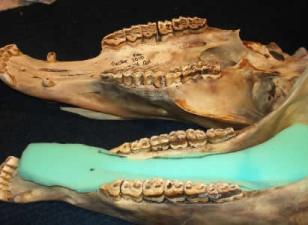
Both jaws, opened up - upper jaw is above (the green foam is placeholder for the tongue - they didn't have pink at the fabric store...). |
In December 2009 a neighbor and friend who lived down the road died suddenly in her sleep. It was a shock, completely unexpected, and she left behind eight dogs, a very nice old horse, and a devastated husband of 30 years who didn't know what to do with the horse (whose name is Tucker).
Word went round and I had an empty stall in my barn, so I offered to take the old boy in. He's a small, cute sorrel Quarter Horse, 20 yrs old, who had taken really good care of his late owner. I don't need another horse, but he's quiet and gentle and an easy keeper, and it seemed like the right thing to do. And a horse that's old enough to be kid-safe but still healthy is not easy to find.
Well, good intentions rarely go unpunished. A few weeks later this very sweet old boy went off his feed on a Friday. On Saturday morning he was clearly in pain, still off his feed (of course, these things always happen on the weekend, don’t they?) so I'm thinking "colic". Took him for a walk, which was slow and painful for him, and he pooped (good) – a gooshy, black, very stinky pile (bad). Called the vet, gave him some Gastro-Gard and Banamine, which seemed to help a bit, and let him rest… but by dinner he was worse off, so I had the vet out. Tucker was in a very bad way and there was no choice but to put him down. Unfortunately it was after dark, outside, and we couldn't do an autopsy – but it was clearly a massive internal hemorrhage of unknown cause that took him. Whatever it was had probably been coming for some time, because from the day I brought him home he was never sprightly or kicky-bucky out in the pasture like the other horses, but since I didn't know him I couldn’t tell if this was natural or a change in his behavior.
I was sad to lose him but relieved to have his pain end. He's the third horse I've lost, and it's gotten a little easier. I don't know if that's because I don't feel responsible for his illness, or because it's not such a kick in the gut the third time around, or because in the face of such dire, un-fixable pain all that matters is to end the pain. Whatever the reason, I'm sure it was easier on my vet to not have me weeping.
In the end, they each leave hoofprints on our hearts. Rest in peace Tucker, and Maddie, and Bullet.
So, now more on Tucker, the dear old boy who died a month after I adopted him. Well, I live out in the country, and I have the good fortune of being able to bury my horses on my property (unless they die when the snow is too deep). Not that they die often – but on those rare occasions it's been nice to say goodbye and bury them at home. When Tucker died I had this great idea: Save his skull! It's darn hard (and expensive) to find a horse skull to use as a teaching tool, and here it was, just waiting for a little taxidermy. And what a teaching tool it turned out to be!
I won't go into the details, except to say that no, it wasn't macabre (once the spirit is gone, the body is just meat and bones), and yes, it was hard work. And in the words of a friend's fascinated 7-yr-old daughter, Tucker's skull is his gift to all of us.
So, here's my point: Tucker's skull is a terrific example of why horses need dental care. I am very big on dental care for horses (and dogs), because without it they can suffer tremendous pain even just eating, let alone from being ridden with tight cavessons, nosebands, and bosals.
Tucker had clearly not had dental care for a long while. The pictures of his skull show teeth that are not just sharp-edged, pointed, and hooked on the outside edges of his upper teeth (where a tight noseband would press his cheeks in and cause pain) and the inside edges of his lower teeth (where his tongue would rub), but a more serious condition caused by not flattening out surfaces where his teeth grind together.
The lower teeth, both sides, have developed a "wave"; instead of being a level surface from front to back, the teeth rise up to form a sort of hill in the middle. That wave on the bottom actually pushed apart the top teeth to form a gap on each side that was packed rock-hard with old food (took me a while to dig it out), and bone deterioration was setting in under the packed food in the gaps. My vet tells me it was very painful for him to eat, and he would certainly have lost those teeth and possibly/probably developed abscesses.
Poor old Tucker. Had he not died so suddenly, I would have had my vet fix those teeth – but someone should have prevented those bad teeth from ever developing a long time ago. So, learn from the pictures (thank you, Tucker) and don’t ignore your horses' teeth.
|

